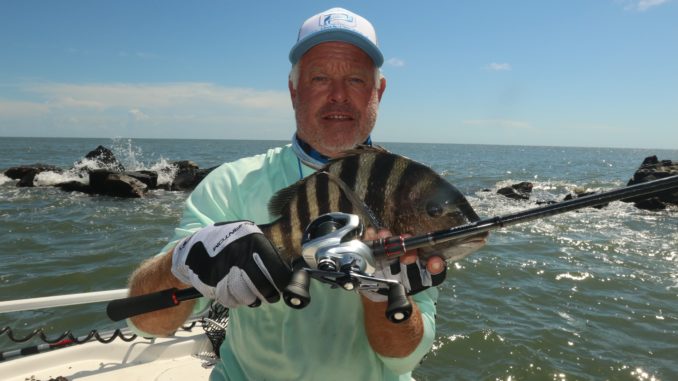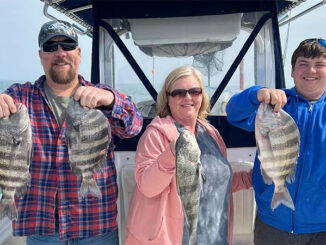
Crustaceans are No. 1 on the menu for inshore battlers
The middle of another Carolina summer is upon us, and while plenty of offshore and inshore options exist, it’s prime time to catch sheepshead around the rock jetties scattered up and down the coast.
The rock jetties that straddle Little River Inlet along the border between the two Carolinas are among the best places to find sheepshead during the heat of the summer.
Little River Inlet is sandwiched between two uninhabited, barrier islands, Waties Island to the west and Bird Island to the east. Unlike many jetty systems, Little River transports flow from much more than just Dunn Sound and the Calabash River; it receives substantial flow from the Waccamaw River through the Intracoastal Waterway. Not only does the Waccamaw provide a black, tannic tinge to the ocean, these waters transport nutrient-rich flows that enhance growth in this tiny estuary and along the giant, granite boulders protecting Little River Inlet. Sheepshead and an entire host of familiar finned critters gravitate to this system to feast.
Sheepshead will eat a variety of foods, but they prefer barnacles, mussels, shrimp and other hard-shelled creatures. The jetties provide a perfect dinner table that can support a large population of hard-shelled delicacies. But these jetties can bring swift currents and dangerous conditions for boaters. It takes an experienced angler to navigate these perilous areas and catch good fish.
Mitch Stines of Camden, S.C., is one of those fishermen who knows how to navigate the jetties, and sheepshead are undoubtedly his favorite marine fish to target.
“I first started fishing for sheepshead in 2006, and I have been hooked on it ever since,” Stines said. “We catch plenty of fish during the middle of the summer when it’s hot. I am still trying to beat my 11-pound personal best from the jetties at Georgetown, and I have caught several that have come close.”
Stines has fished for sheepshead around just about every kind of hard structure, but he prefers the jetties because the window of opportunity is so much longer than inshore — and there are just more fish out there.
“You can catch sheepshead on pilings, but the best bite only lasts around 30 minutes,” he said. “At the jetties, you have a lot more structure for the sheepshead to be around and a much-longer interval to fish when conditions are best. I like to fish the incoming tide best, and the more water over the rocks, the better the bite will be.”
As the tide rises, sheepshead begin to feed upward on the structure as it gets flooded. Stines will fish on both jetties and on both sides of the jetties, depending on the current. He likes to set up with his boat tight to the rocks, choosing the side with the calmest conditions.
“The fish are right in the rocks feeding, so that’s right where I fish,” he said. “You may lose some tackle or a lot of tackle, but that is where the fish are.”
Stines uses light tackle to give him a direct link to the sheepshead, along with 10-pound line and a drop-shot rig with a small hook. The bite is typically characterized by a subtle tap.
“Unlike the typical Carolina rig people use, you can feel every bite with the drop-shot rig on light line,” he said.
Fiddler crabs are his staple bait; he will make sure he has more than enough to fill out a day, because when the fish start biting, he will go through a bucket of crabs in a hurry. He usually doesn’t mind, because he will normally boat several dozen sheepshead in exchange.
“When you are losing bait, you are usually catching fish. It’s a good trade off,” he said.
While the summer is the best time of year for sheepshead at the jetties, they will be chewing away crustaceans and mollusks off the boulders well into the fall.



